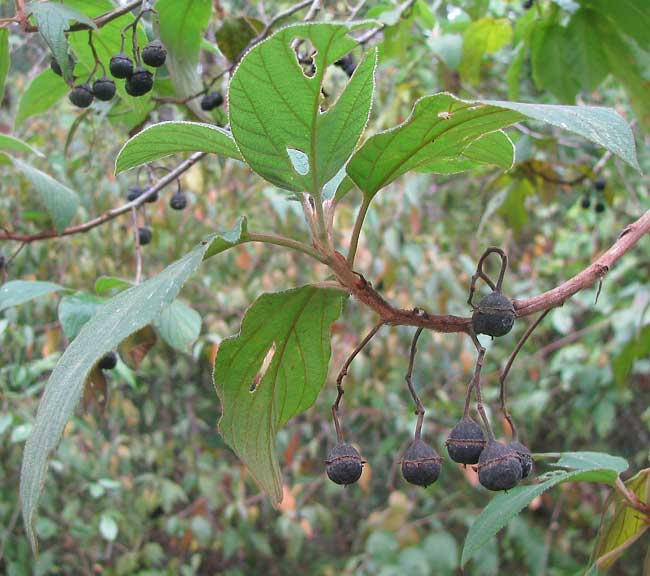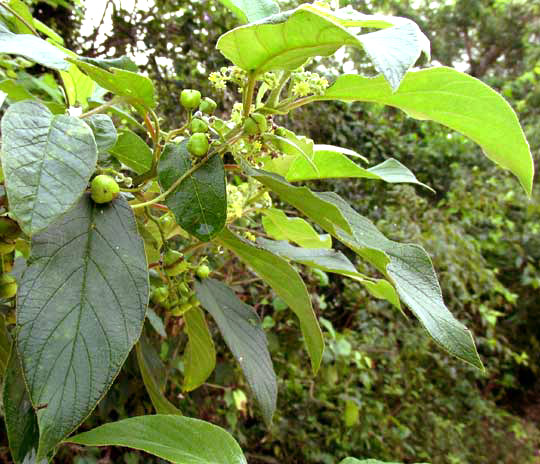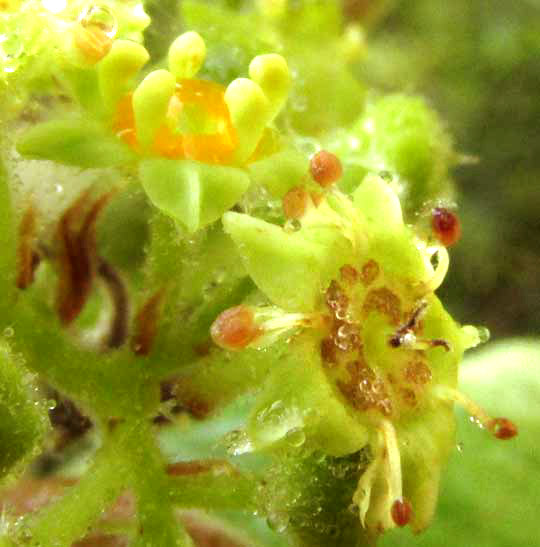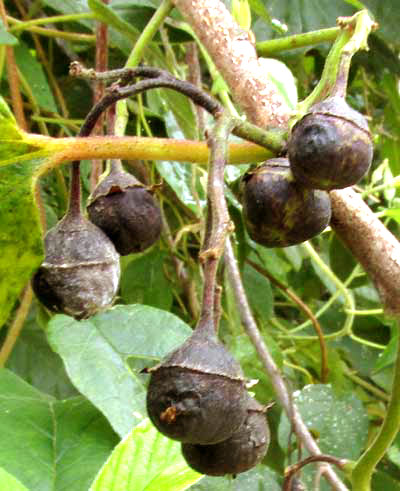Excerpts from Jim Conrad's
Naturalist Newsletter
from the January 17, 2010 Newsletter issued from Hacienda Chichen Resort beside Chichén Itzá Ruins; limestone bedrock; elevation ~39m (~128ft), N20.675°, W88.569°; central Yucatán state, MÉXICO
NAKEDWOOD
A fairly common, somewhat weedily growing bush or small tree is bearing fruits these days that are eye-catching because they turn black at maturity, as shown below.

If you recall the several densely bushy, spiny members of the Buckthorn Family, the Rhamnaceae, we saw in the Oregon mountains last summer it might be hard for you to visualize the plant in the picture as belonging to the same family. It does, however. It's COLUBRINA ARBORESCENS*. One of its several English names is Nakedwood.
The Maya here say that they don't use the tree for anything and that only the birds care for the fruits.
However, it's clear that it's noteworthy simply as a fully engaged member of the local ecosystem. A few weeks ago when its tiny, yellow-green flowers were blossoming I saw them buzzing with honeybees taking both nectar and pollen. Many other insects, especially butterflies and diurnal moths were attracted as well, which in turn attracted bug-eating birds, especially vireos, flycatchers and migrating warblers.
from the November 29, 2015 Newsletter issued from Hacienda Chichen Resort beside Chichén Itzá Ruins, central Yucatán, MÉXICO
NAKEDWOOD'S FLOWERS
Back in 2010 the shrub was noticed too late in the season to photograph its flowers -- it was January -- but now in November I find Nakedwood producing small, dense panicles of greenish flowers, as shown below:

Up close the individual flowers prove to be strange and beautiful, seen below:

There you see two flowers, the lower one older than the top one. The flowers' triangular, green, petal-like appendages are sepals, or divisions of the calyxes. Between the sepal bases the stamens with their brown, pollen-filled anthers are nestled within scoop-shaped, green petals. Notice that on the lower flower the petals and stamens bend backwards but on the younger top flower they are erect, with the petals practically surrounding the stamens. The story here is that as the flowers mature, they first keep their stamens upright and hidden/protected by the scoop-shaped petals, but when the flowers are mature, the stamens bend over the flower's side and separate from the petals. This action not only shields the stamens until they are ready to shed pollen, but also puts the anthers in a position so that the pollen doesn't fall uselessly into the center of the flower.
In the top flower the golden-colored ring is a fleshy disc, typical of the Buckthorn Family, the Rhamnaceae, to which Nakedwood belongs. In the more mature lower flower I think the brown blotches are where an insect has nibbled at the disc.
On the same bush a few fruits already were maturing, shown below:

The species Colubrina yucatanensis, wasn't recognized when I first profiled it in 2010. Since then, in 2013, Guy Nesom published "Taxonomic Notes on Colubrina (Rhamnaceae)" in the journal Phytoneuron, in which Colubrina yucatensis was raised to species level from being a mere variety of Colubrina greggii.
Our Yucatan Nakedwood as now conceived is endemic just to the Yucatan Peninsula and northern Guatemala. The "type specimen" -- the plant from which the species originally was described for science, was collected just a few hundred feet from the hut, beside the Sacred Cenote at Chichén Itzá.